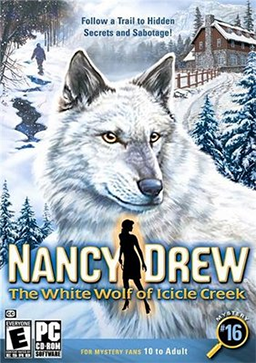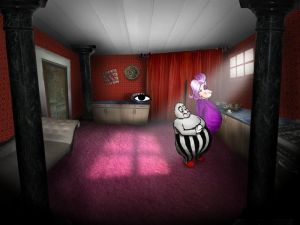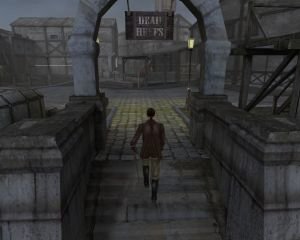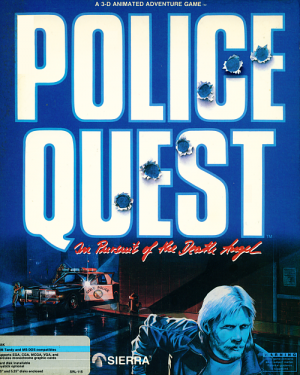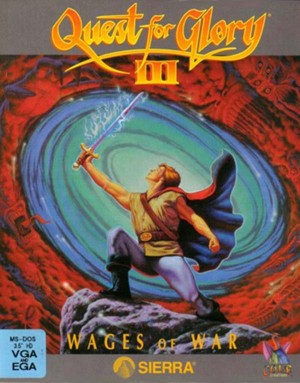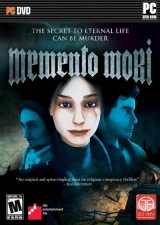Review for King’s Quest II: Romancing the Stones

After heroically recovering the three lost treasures of Daventry from assorted looters in the first King's Quest, the new monarch – erstwhile knight, Sir Graham – has restored the kingdom to its old glory. The citizens are cheerful once more, enemies are taking a breather, and all's well with everyone... except Graham. The crown sits heavily on the head of the young man whose adventurous life has come to a standstill amidst the daily drudgery of administering the peaceful and prosperous province. While not dozing off during dull recitals of statistics by his advisors, nearly-bored-to-death Graham spends his days half-heartedly trying to find a bride for himself. His efforts are wasted, however, as he has little patience for wannabes and sycophants. But since he's the king, his soirées to hobnob with potential suitors are naturally doomed to be populated with precisely those sorts.
And so it goes until the day his security advisor, Gervain, suggests that Graham seek a clue to his future in the Magic Mirror. As he peers into the glowing glass, Graham is swept away on a virtual rollercoaster ride through the neighbouring land of Kolyma, his flight of fantasy ending with an enticing, irresistible glimpse of a lonely tower on a psychedelic island. Entrapped within is a beautiful maiden, and it's love at first sight for Graham, who immediately exchanges his crown for his feathered adventuring hat, collects his sword, and sets off on his galleon to rescue her. Meanwhile in Kolyma, warty witch Hagatha is informed by a mysterious entity – who she addresses as Father – that Graham's about to stick his neck out to rescue the damsel in distress, and that her new priority is to “sever it”.
AGD Interactive's King's Quest II: Romancing the Stones is an inspired remake of Sierra’s King's Quest II: Romancing the Throne, originally developed way back in 1985. AGDI's version is based on the same characters, and retells “with gusto” the tale of Graham's quest for his bride. First released in December 2002, Romancing the Stones is an epic labour of love not just from Graham, but also the tiny development team behind this remake, featuring over 15 hours of complex storytelling, a fantastic script, intricate plot twists, challenging sub-quests, delightful old-fashioned VGA graphics, soaring MIDI-style orchestral music, extensive and expert voice acting, and most importantly, a faithful recreation of Sierra's later point-and-click interface instead of the dreaded text parser that fuelled the original. It's not a perfect game, hobbled in places by vague gameplay, clunky navigation, far too much clueless walking around, and a reliance on sheer luck to trigger randomly-initiated events, but I suspect part of that is intended to retain the flavour of adventuring in the golden days – the era of 16-colour EGA graphics and (gasp!) no World Wide Web (read: no handy walkthroughs), when it could take months to complete a game. On the bright side, the game is totally linear and has no dead ends, just nasty surprises that temporarily kill Graham and maim your ego (if you've been conscientious about saving).
Graham's quest starts in earnest once he's dropped off on a pier at Kolyma. The story unfolds over the next day-and-a-half as he scouts the perilous area riddled with real and magical dangers, runs errands for sundry locals in exchange for useful information and items, fights various breeds of evil that directly and indirectly ail Kolyma, and eventually locates the mystery tower. Initial exploration leads to an encounter with the ‘Stone of Destiny’, a gravelly-voiced rock face which informs Graham that he needs to find the three ‘Gems of Nature’ to succeed. At this point the game becomes literally multi-dimensional, as besides ransacking Kolyma and its outskirts, Graham must also delve underwater to negotiate with King Neptune and make time for a walk in the clouds.
The first few games of the King's Quest series were laden with concepts from popular fairytales and mythologies, and Romancing the Stones stays true to this theme, devoting detailed plotlines to stories such as Little Red Riding Hood, The Ugly Duckling, Aladdin and Dracula. The remake, however, takes the original game to a whole different level of excellence, delving deeper into the plot and greatly expanding its complexity, ramping up difficulty with creative situational and inventory puzzles, and giving every character – human, undead, fish, flying horse and pumpkin – distinct, engaging personalities. The update also actively tackles the eternal conflict between right and wrong, often presenting dilemmas directly to Graham (and therefore the player), who must choose the one solution that best suits his unimpeachable moral integrity while ensuring that others are not judged solely on their apparent nature – quite a few seemingly evil creatures eventually reveal hearts of gold, and far friendlier entities just as shockingly are exposed as turncoats.
The game world, which includes a lengthy coastline, an endless swamp and a sprawling forest, can feel overwhelming until you get a hang of the 'blocks' that each location is broken into. In the original game, the map wrapped around so that if Graham kept walking in one direction, he'd eventually end up at square one, but that's not the case here, with each location ending physically in all four directions. While more logical, this exponentially increases the amount of backtracking from one corner of Kolyma to another, a problem compounded by three issues: Graham walks reasonably fast but doesn't run; the next course of action is often unclear and the only way out is to roam around hoping to stumble into either a new crisis or the solution of an existing one; and many events are triggered by other events or the day/night cycle, and these locations must be revisited frequently just to check if they've become active.
Besides walking, Graham can look at, touch and talk to everyone and everything. Each action elicits a comment from the narrator’s staggering database of witticisms, and absurd moves earn verbal raps on the knuckles (“The tree looks climbable, just as you look breakable.”) You can cycle through the actions either by right-clicking or rolling over the menu at the top of the screen and selecting the desired icon. Graham can also be moved using the keyboard, and while sometimes this is inconvenient when he gets 'stuck' against screen elements like trees and rocks, overall this is the quickest way to navigate. You'll gather quite a few odds and ends during your quest, but the remake refrains from the indiscriminate object collection that commonly plagued adventure games of that era. On the downside, hotspots aren't labelled in any way and many are present only to add intricacy to the settings, which leads to many unhelpful clicks. Objects in the inventory can be looked at, felt and used with on-screen hotspots or with each other, though inventory combination puzzles are infrequent.
There are a total of 185 points to be scored, ranging from 1 point for collecting a regular inventory item up to 7 for solving key sub-quests. Several tasks have multiple solutions and outcomes, and points are awarded based on what method of resolution is used and how accurately you match Graham's ideal decision – which isn't as easy as it sounds, because while he's a predictably noble guy, decisions have to be made from multiple honourable choices as well. Obstacles cover the entire gamut from inventory puzzles to standalone cerebral teasers and even a few arcade challenges. Most puzzles are well-integrated, such as locating a source of light under the ocean, finding a book in a massive library, stealing a noisy object from Hagatha's cave while she's brewing a potion, and creating an enchanted gem, albeit with some ambiguous ingredients. Romancing the Stones doesn't indulge in wanton mix-and-match of objects and hotspots, generally keeping solutions logical and easy to surmise, restricting the challenge to locating and/or procuring the items in the first place.
Not that there aren't some turkeys: it cost me an hour of utter frustration to enter a tree house even with the help of a walkthrough, and many situations that occur arbitrarily demand entering and exiting those scenes multiple times. Some puzzles use randomly-generated codes and patterns that must be noted down by hand in the absence of a diary or any option to revisit dialogues. There’s no quest list available either, but the game's linearity does a good job of keeping the adventure on track. The arcade tasks aren't difficult per se, but the sluggish navigation system, combined with the fact that each action and inventory cursor has only a tiny point that can interact with hotspots, turn many timed sequences unnecessarily deadly while fiddling with the keys.
In true Sierra style, almost every step of Graham's journey is fraught with fatal risks. He can die in an insane number of ways: impaled on sharp objects, blown up by explosions, bitten and eaten by various carnivores (this category includes the most visually cringe-worthy demise courtesy the Sharkees, the aptly-named marine ravagers), falling off cliffs and bridges (sometimes even during innocuous strolls), drowning in water bodies, melting in the poisonous swamp, and more – the list is painfully long. He can also be mugged, captured and killed by villains like Hagatha, a thieving dwarf, and the Big Bad Wolf. Each death – almost always startling if not downright spectacular – is followed by a snarky obituary (“You saw a Sharkee in the sea, he quickly made a meal of thee.”, or after getting his life force drained by ghosts: “Maybe you’re taking the ‘can’t beat ‘em, join ‘em’ philosophy a bit too seriously.”) and the option to restore the last saved game from the 50 available save slots. The obituaries sometimes hold clues to resolving the lethal situation, but these are usually too subtle and useful only in retrospect.
Romancing the Stones is strewn with all sorts of characters – human, animal and supernatural. Graham is the quintessential knight in tight red shirt who’s handsome, kind and charming, if a little naive, and carries the game on his broad shoulders with élan. The supporting cast is memorable in its own right, be it the insecure witch Hagatha, adorable little girl Possum, swanky vampire Count Caldaur, the shady junk merchant who talks like Yoda when in his element, a fierce mother pumpkin, the world's crankiest librarian who's overwhelmed by managing all of two (dead) members, or the slinky mermaid who steams up the screen with Graham in her cameo. There's an incredible amount of verbal and text content, including object, location and event descriptions, instructions, letters, books, dialogues and obituaries. Most sentences are layered with multiple meanings, and great care has been taken to keep the player connected – and often outright amused – through the otherwise serious proceedings.
The lavish game world is enriched with hundreds of quirks both deliciously subtle and ridiculously over-the-top, from the modern mailbox outside Grandma's cottage to the berserk Batmobile that swerves in and out of Hagatha's 'batcave' to pounding rock music. Kolyma's library stocks books like ‘Icebergs and Unsinkable Ships’ and ‘The Brady Bunch’ (which warns that prolonged exposure to it may alter the reader's perception of reality), while the local antique shop has a 'DX cartridge retrieval unit', one of the many shout-outs to Sierra sister series like Space Quest and Quest for Glory. But the game also suffers from the problem of plenty; with so much information on offer over so many hours of gameplay, a documenting system is sorely missed. Accidentally clicking during conversations can cause descriptions and clues to be permanently missed, and even with due diligence, recollecting the right instruction at the right time is quite the task.
All this action is set against a vibrant canvas of VGA art which, together with the MIDI-style music, heaps on the nostalgia while building the perfect ambience for every scene, whether pleasant, macabre, or downright nerve-wracking. The night scenes, shaded in blue and hosted under a star-sprinkled sky, are creepy and forbidding, as is the ocean infested with menacing saw-toothed fish. The pixelated graphics do not distract from the meticulously rendered landscapes replete with reflections in water and glass, flickering flames, and wavering beams of sunlight when underwater. Despite not being highlighted in any way, interactive objects are plainly visible in their natural environments, and any new objects introduced since you last visited are pointed out by the narrator.
Conversations occur in inset boxes with close-ups of the speakers, and the expressions and lip-syncing are perfectly matched with the extensive voice acting throughout the game. Josh Mandel, who voiced Graham in Sierra’s King’s Quest editions V and VI and AGDI’s remake of King’s Quest I, once again does the honours with aplomb, and is competently supported by his co-actors, including the mildly-indulgent, omnipresent narrator. The developer’s attention to detail extends to this area as well, as Graham’s speech is garbled when he speaks underwater, and he sounds painfully choked when being strangled. Sound effects are equally convincing and not limited to the screens they occur in: the ocean’s rumble and the tolling of the church bell, for example, are faintly audible in the neighbouring screens as well.
Overall, this remake’s lengthy, twisting story is wrapped tightly around the locations, characters and puzzles, setting up a new mystery each time an existing one is solved. Aside from a few obtuse challenges, the plot stays logical and realistic within the limits of its supernatural premise. Graham is a worthy hero, and it’s a pleasure to explore Kolyma with him, from the idyllic seaside locales to bizarre castles and creepy cemeteries. Also delightful is the abundance of dialogue, which takes the sleek production to another level, enchanting every scene with unusual depth and humour. Admittedly, there’s room to nitpick: some issues are genuine while others were artificially created to stay true to the game’s decades-old inspiration, and those who prefer quick resolutions to crises should keep their walkthroughs close by. But for fans of classic adventuring, the numerous moments of brilliance and nostalgia are sure to far outweigh the occasional stretches of frustration, and honestly, what can beat the fact that this game is available for free – really! – on AGDI’s website. A note on the site states that as of September 2010, the original release and its four updates have already been downloaded more than half a million times, a testament that King’s Quest II: Romancing the Stones is a true, sparkling gem in the treasury of adventure games.



_capsule_fog__medium.png)






